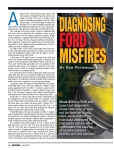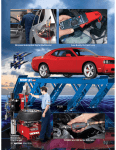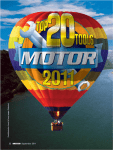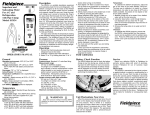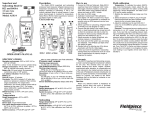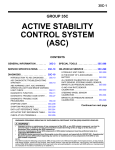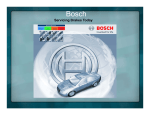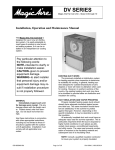Download You Brake It, You Bought It:
Transcript
You Brake It, You Bought It: AVOIDING BRAKE SERVICE SURPRISES A s an experienced service technician, how often do you consult the service manual prior to servicing a vehicle’s brake system? Are you the type who consults the service manual only when you get stuck, or do you take the time to review repair procedures in advance? Brake system service is one repair area often taken for granted. Most of us wouldn’t hesitate to rack a vehicle, pull the wheels and begin performing a brake inspection or repair without any additional guidance. We rely on our experience to alert us to potential problems, but on some late-model vehicles, if you’re not careful, you might have a nasty surprise waiting for you during the repair. Depending on how old you are, you might remember seasoned technicians complaining about the transition from front drum brakes to front disc brakes, or about the addition of rear disc brake systems. I can remember comments like, “What new tools am I going to have to buy to repair these new systems?” Or, “Why do they have to complicate things?” In the early days, you could repair virtually any brake system with four or five basic tools. Did you find yourself making the same comments or complaints when you had to purchase a tool to depress the rear disc brake caliper piston, by rotating the 26 June 2009 piston into the caliper? This new tool is required for vehicles with parking brake systems that mechanically adjusted the rear disc brake caliper piston. Vehicle braking systems have changed over the years, but they remained very simple for the most part and, up until 10 years ago, still required very basic tools. The addition of antilock braking systems (ABS) became a very big concern, and many of us attended training sessions to learn how to handle potential problems. This was a big leap for many technicians, because now electronics were involved in mechanical systems. The basic brake system now included ABS control modules, wheel speed sensors and electrically operated hydraulic actuators. Technicians who never needed or wanted to use a scan tool now needed one for some basic services. The scan tool is now an essential part of brake service. The good news or bad news, depending on your perspective, is that antilock braking systems don’t fail very often, and in most cases the basic service can be performed without the use of a scan tool or other unique procedures. Up until a few years ago, the primary use for a scan tool was for checking ABS codes and bleeding the brakes following a hydraulic module replacement. For the most part, that’s still the case. Photoillustration: Harold A. Perry; photos: Wieck Media & Jupiter Images BY BOB PATTENGALE When proper procedures are overlooked or ignored, brake service can make a quick transition from ‘NBD’ to ‘OMG!’ Something as (seemingly) simple as installing a set of pads could ruin shop profits or cause injury. June 2009 27 AVOIDING BRAKE SERVICE SURPRISES Parking Brake Solenoid Photos & screen captures: Bob Pattengale Electrical Connection The 2004 Audi A8 uses an electronic parking brake system. The rear disc brake caliper (left) has an electronic motor attached to apply pressure to the brake pads. The motor must be retracted using a scan tool before the caliper piston is depressed. The system is activated by a switch (right) mounted in the console. The advent of new braking technology, as well as fluid servicing systems and the appearance of hybrid vehicles, are changing how some of these systems are serviced. Let’s take a look at a few examples. Electronic Parking Brake System Vehicle manufacturers are looking for ways to reduce weight and enhance vehicle safety systems. One system that’s seeing wider application is the electronic parking brake system. Audi began using this on the 2004 A8, and it’s now standard on all 2009 Audi vehicles. The electronic parking brake system uses a rear disc brake caliper that looks standard, except for the solenoid assembly attached to the back of the caliper. The driver uses a switch on the center console to request parking brake engagement. This request is received by the electronic parking brake control module, which then applies electrical current to the parking brake solenoid. The control module determines the motor cutoff point by evaluating the motor’s power consumption. In other words, the control module monitors the amperage used to apply pressure, and cuts power once the amperage reaches approximately 16 amps. One interesting feature: If the parking brake has not been used during the last 620 mi. (1000km), the control module automatically adjusts the parking brake. The parking brake adjustment is critical for the DriveAssist feature on manual transmission vehicles. The park- 28 June 2009 ing brake is automatically applied based on vehicle tilt angle, accelerator pedal position, clutch pedal position and clutch pedal movement speed. It’s released when the driver moves from braking to acceleration. Imagine you’re servicing this vehicle for the first time. Would you begin the service right away, relying on experience, or would you consult a service manual first? What you decide to do will make the difference between a good repair and a big mistake. Let’s look at this service. In this example, you decide to jump into the service without instruction from the service manual. The caliper is easy to remove—basically, remove two bolts and the caliper slides off. The brake pads are a straightforward removal process, too. You inspect the caliper and determine it’s reusable. The next step for most technicians would be to depress the caliper piston, so you pull out your trusty brake caliper piston depresser and begin applying pressure to the piston. The piston moves a little, then stops. What now? Well, you think maybe the piston is stuck or cocked a little, so you apply more pressure. Then you hear something snap. This is when the swearing begins. What just happened? You just damaged the parking brake motor assembly, which might cost you as much as $800 for one caliper. This is where you finally consult the service manual for the proper procedure for servicing this system. The proper procedure involves using a scan tool or electronic device to retract the motor. Once the motor is retracted, you can depress the caliper piston in the conventional manner. The screen captures on page 30 show part of the scan tool functional test required to properly retract the parking brake motor to service this system. Once the brake service is complete, the scan tool is used to properly adjust the parking brake motor. Hybrid Brake Pad Replacement You may never have thought that a scan tool would be required to replace a few brake pads. But this is the future of brake service. And we’re not done; let’s look at another example—a Ford Escape. You’re thinking, Piece of cake. I’ve serviced hundreds of Fords. You rack the vehicle, pull the wheels, perform your brake inspection and recommend a complete brake service. As you’re making notes on the work order and performing the underhood vehicle inspection, you’re reminded that this is a Ford Escape Hybrid. In the back of your mind you wonder if there’s anything unusual about this vehicle. Your only service on this vehicle is brakes and you just finished a complete visual inspection, including master cylinder and hydraulic control assembly, and nothing looked different about the braking system. This looks like a standard braking system with antilock brakes, so you decide to move forward. The job is approved, so you dig in without consulting the service manual. The calipers are loose and you’re getting ready to machine the rotors. The AVOIDING BRAKE SERVICE SURPRISES brake lathe is across the shop and you’re surprised by what happens next. Without warning, the caliper pistons shoot out of the calipers. What just happened here? No one touched the vehicle, the key was not even in the ignition and as a normal precaution you placed the keys on your workbench. The vehicle decided to perform a random system check and when the brake system pressurized, there was nothing to hold the caliper pistons in place. I’m guessing most of us would be shocked at this turn of events. Let’s take a look at what the service manual recommends: Step 1: With the vehicle in Neutral, position it on a hoist. NOTE: The following steps must be taken to prevent the accumulator from charging and pressurizing the brake system. Step 2: Disconnect the battery. Step 3: Remove the battery junction box (BJB) fuses 24 (50A) and 31 (50A). Step 4: Service the brakes in the normal manner. Would you have thought to disconnect the battery for a brake service on this vehicle? Ford technicians say you can also use the Ford factory scan tool to disengage the braking system. I asked more than a half-dozen Ford dealer techs and they were evenly split; some used the scan tool and others disconnected the battery. The bottom line is you need to perform one of the above tasks. Again, don’t assume anything; you must look up the proper repair procedure. One interesting note about the Ford Escape Hybrid is that the rear brake 30 June 2009 The parking brake system on the Audi A8 is controlled by a separate control module. These images, taken from the Bosch KTS-570 scan tool, show part of the process of retracting the parking brake motor prior to brake pad replacement. pads wear at approximately twice the rate of the front brake pads. This is because regenerative braking is used to help stop the vehicle. Since regenerative braking uses the hybrid electric motor to slow the vehicle’s front wheels, front brake pad wear is reduced. The opposite is true on most vehicles. The front brake pads wear at approximately twice the rate of the rear. Most shops perform some type of preventive maintenance inspections and make recommendations for future services. Understanding the difference between conventional and hybrid braking systems is important if you want to estimate when the rear brake pads might need service. Flushing the Brake System Brake fluid flushing is a maintenance item now commonly performed in most shops. Again, the question is, Should you perform this service without consulting the service manual? By now your answer should be No, but let’s take a look at the following example. You just completed a brake service on a 2004 Chevy Silverado 1500 4WD, which included a complete brake fluid replacement. You’ve performed this same service on other vehicles with no known issues. After flushing the brake fluid on this vehicle, the brake pedal feels spongy. Your first thought is that maybe one of the calipers has some trapped air, so you perform the bleed procedure again, with the same results—a spongy pedal. What should you do now, try again? The obvious next step is to check the service manual. In this case you’ll find a long description on how to perform the Hydraulic Brake System Bleeding (Pressure) using a pressure bleeder. After reading this and following all the procedures, you get to Step 26, which states: If the brake pedal feels spongy, perform the following steps: Step 1: Inspect the brake system for external leaks. Step 2: Using a scan tool, perform the ABS Automated Bleed procedure to remove any air that may have been Illustration courtesy of the University of Toyota scan tool, the pump and solenoids would be cycled to allow for complete fluid replacement. Brake fluid flushing is now a common practice. The question is, How would you know if an automated process is available? The service manual will provide the correct procedure. ABS Diagnostics Flushing the brake fluid has become a common vehicle service. This illustration shows a typical Toyota ABS hydraulic system. If you performed this service without the aid of a scan tool, the only fluid that would be replaced is shown in red. The old fluid will still be present in the yellow sections of the system. trapped in the Brake Pedal Modulator Valve. The ABS Automated Bleed Procedure is 16 steps long and includes a possible repeat of the pressure bleeding process. The key point is knowing in advance that you might need to perform the Automated Bleed Procedure if the pedal is spongy. You would have wasted valuable time attempting to repeat the pressure bleeding process. Also, what if your scan tool doesn’t have this feature? It would be a good idea to check your current scan tool in advance. If your scan tool doesn’t have this Special Function, don’t perform this service. What’s the benefit of performing a brake bleeding procedure with a scan tool? The diagram on this page shows the typical hydraulic passages in an ABS system. The red passages represent brake fluid flow during normal braking. If you were performing a basic brake fluid flushing process, the fresh brake fluid would travel through these passages. But what about the yellow passages? In this example, the old brake fluid in the yellow passages would not be replaced. If you were performing an automated brake fluid service with a Some vehicle manufacturers have begun using freeze frame captures for ABS trouble codes. The ABS module captures information from various components and sensors to help the technician determine what part of the system might be at fault. This capture, from a 2007 Dodge Durango, shows that the right front wheel speed sensor reading does not match those of the other three sensors. Up to this point we’ve focused primarily on brake service issues. But what about diagnostics? ABS diagnostics requires the use of a scan tool with a variety of features. The scan tool must be able to retrieve trouble codes, display data and perform various system tests. Most scan tools with ABS coverage offer these features. One fairly new feature is ABS Freeze Frame Data, which is similar to an OBD II freeze frame capture. Whenever an ABS trouble code is detected, the ABS control unit stores information at the time of the event. This data can be used to determine possible causes or conditions when the trouble code was stored. The screen capture on this page is from a 2007 Dodge Durango with a C101F Right Front Wheel Speed Comparative Performance trouble code. This code sets when the right front wheel speed sensor reading is different from the readings of the other sensors, when the vehicle speed is above 25 mph. As you can see, the right front wheel speed sensor is 71 mph and the left front wheel speed sensor is 30 mph. Obviously, the right front wheel speed sensor and/or circuit needs to be inspected for potential issues. The next time you have an ABS trouble code on a late-model vehicle, check to see if freeze frame data is available. Hopefully, by now you get the picture. Brake system service is not as simple as it used to be. If you’re not 100% sure about how a system is serviced, refer to the service manual. It This article can be found online at www.motormagazine.com. June 2009 31






